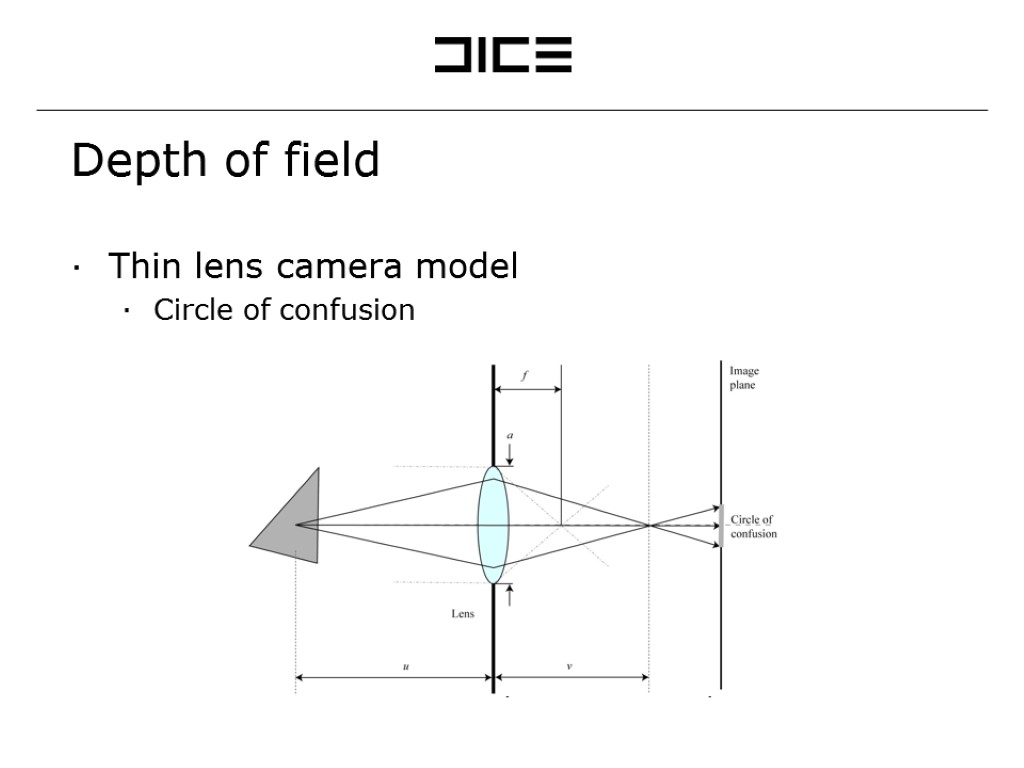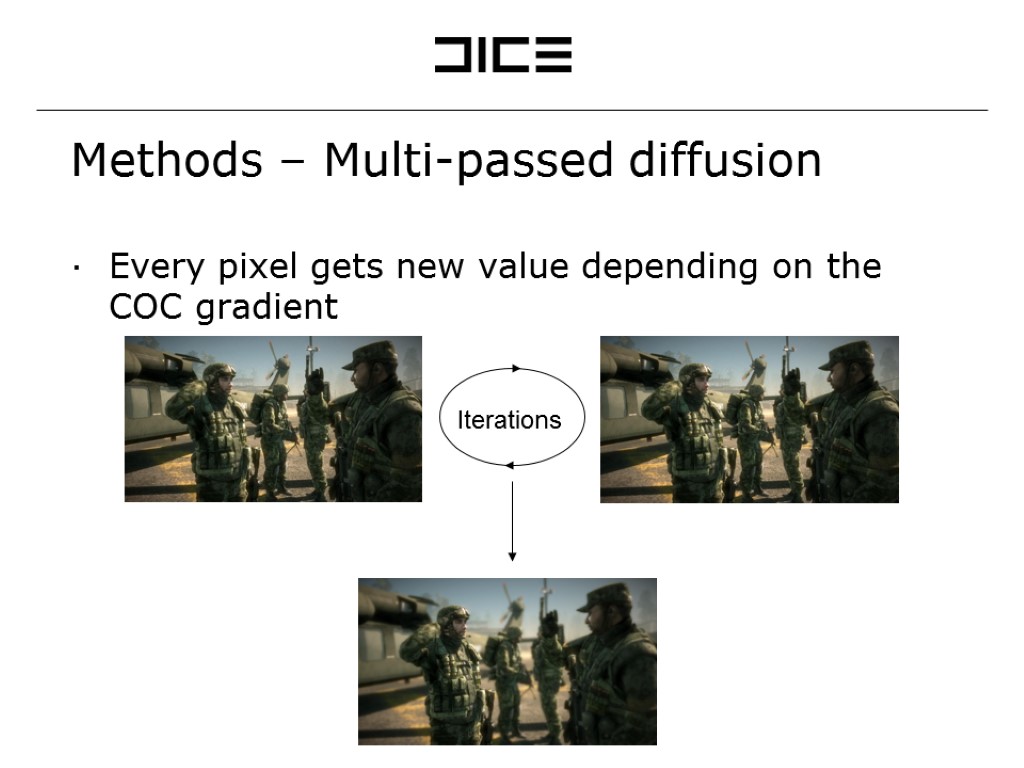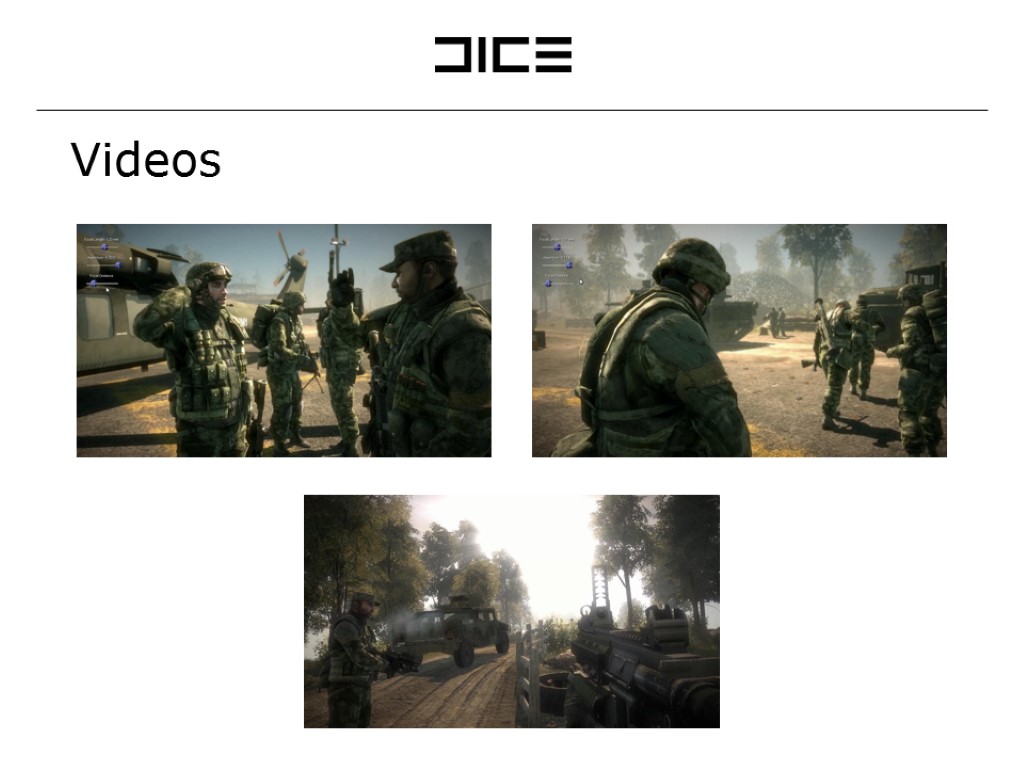 Advanced Real-time Post-Processing using GPGPU techniques
Advanced Real-time Post-Processing using GPGPU techniques
 Presentation overview Problem description and objectives Depth of field Methods GPGPU programming Results Conclusion Questions
Presentation overview Problem description and objectives Depth of field Methods GPGPU programming Results Conclusion Questions
 Problem description and objectives Post processing filters Different depth of field algorithms Visual quality Implement using HLSL and CUDA Performance Usability
Problem description and objectives Post processing filters Different depth of field algorithms Visual quality Implement using HLSL and CUDA Performance Usability
 Depth of field Depth cue Focus plane Focus in area in front of and beyond Different blurriness
Depth of field Depth cue Focus plane Focus in area in front of and beyond Different blurriness
 Depth of field Thin lens camera model Circle of confusion
Depth of field Thin lens camera model Circle of confusion
 Depth of field Calculate Circle of confusion Depth value and lins parameters Depth map COC map
Depth of field Calculate Circle of confusion Depth value and lins parameters Depth map COC map
 Methods Poisson disc blur Multi-passed diffusion Separable diffusion Summed-area table
Methods Poisson disc blur Multi-passed diffusion Separable diffusion Summed-area table
 Methods – Poisson disc blur Distribution function COC defines scale Downscaled image
Methods – Poisson disc blur Distribution function COC defines scale Downscaled image
 Methods – Poisson disc blur Calculate values and interpolate depending on COC
Methods – Poisson disc blur Calculate values and interpolate depending on COC
 Methods – Multi-passed diffusion Every pixel gets new value depending on the COC gradient
Methods – Multi-passed diffusion Every pixel gets new value depending on the COC gradient
 Methods – Separable diffusion Use a tridiagonal system to represent the heat conductivity Cyclic reduction can solve the matrices for each row
Methods – Separable diffusion Use a tridiagonal system to represent the heat conductivity Cyclic reduction can solve the matrices for each row
 Methods – Separable diffusion Each row is solved independently In each step a reduced tridiagonal matrix is calculated (and output value) until the system is solved
Methods – Separable diffusion Each row is solved independently In each step a reduced tridiagonal matrix is calculated (and output value) until the system is solved
 GPGPU programming General Better flexibility Potential advantages CUDA Extension of C Large community
GPGPU programming General Better flexibility Potential advantages CUDA Extension of C Large community
 GPGPU programming Executes in chunks of threads User specified blocks Several memory types Global Texture Shared Constant More choices and possibilities Hardware specific limits Great potential
GPGPU programming Executes in chunks of threads User specified blocks Several memory types Global Texture Shared Constant More choices and possibilities Hardware specific limits Great potential
 GPGPU programming Gaussian blur timings
GPGPU programming Gaussian blur timings
 GPGPU programming Implementation impact using CUDA + Easy to get started (C) Memory indexing (no more floating point texture indices) Good support for timing on the GPU Good control over computations (threads and memory) - A lot of ”rules” (amount of threads, occupancy, etc) Hard to optimize Beta problems (lack of interop, slow operations)
GPGPU programming Implementation impact using CUDA + Easy to get started (C) Memory indexing (no more floating point texture indices) Good support for timing on the GPU Good control over computations (threads and memory) - A lot of ”rules” (amount of threads, occupancy, etc) Hard to optimize Beta problems (lack of interop, slow operations)
 Results HLSL and CUDA for most methods Exceptions Poisson disc (HLSL only) Summed Area-Table (CUDA only) Timings in runs of 100 on recent hardware
Results HLSL and CUDA for most methods Exceptions Poisson disc (HLSL only) Summed Area-Table (CUDA only) Timings in runs of 100 on recent hardware
 Results Poisson disc timings Separable simluated diffusion timings Multi-passed diffusion timings
Results Poisson disc timings Separable simluated diffusion timings Multi-passed diffusion timings
 Results Artifacts Color leaking Sharp edges
Results Artifacts Color leaking Sharp edges
 Results Input data
Results Input data
 Results Poisson disc Multi-passed diffusion Separable simulated diffusion
Results Poisson disc Multi-passed diffusion Separable simulated diffusion
 Poisson disc Results Multi-passed diffusion Separable simulated diffusion
Poisson disc Results Multi-passed diffusion Separable simulated diffusion
 Lens parameter settings Results
Lens parameter settings Results
 Conclusions Current depth of field filters are good enough Not really, but better is too expensive Cut scenes do get time for more computations GPGPU techniques have great potential Not mature enough (hardware support etc.) Maybe better for other things than image processing Future work Diffusion based approach offers best visual quality Compute shaders anyone?
Conclusions Current depth of field filters are good enough Not really, but better is too expensive Cut scenes do get time for more computations GPGPU techniques have great potential Not mature enough (hardware support etc.) Maybe better for other things than image processing Future work Diffusion based approach offers best visual quality Compute shaders anyone?
 Videos
Videos
 End
End





















































